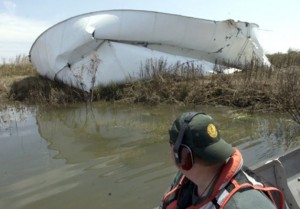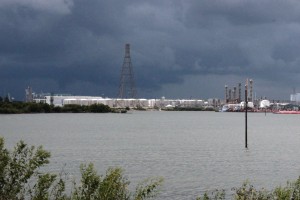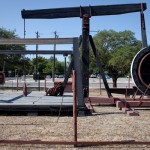How Hurricanes that Hit the Texas Coast Can Float Giant Tanks

Courtesy Beaumont Enterprise
Hurricane Ike in 2008 buckled this petroleum storage tank south of Beaumont
Research engineers say they’re finding that giant storage tanks for petrochemicals and petroleum are vulnerable to damage from tropical storms despite the tanks’ massive size and steel construction. The researchers found multiple cases of flood waters and high winds causing the tanks to float, buckle and rupture.
What the scientists say they didn’t find were regulations to minimize the risk in areas where “storm surge” waters are a threat.
“Overall we don’t see a wealth of any mandated provisions for considering surge or wave loads or external pressures from hurricane events,” said Jamie Padgett speaking at conference held recently in Houston by Rice University’s hurricane research center.
A History of Floating Tanks
Padgett is structural engineer at the university. With the help of students, she’s doing an inventory of above-ground storage tanks in the Houston Ship Channel, so far finding some 4,200 of them. About a third of the tanks are in the storm surge zone. The storm surge is the rise in water caused as a tropical storm churns in the Gulf, pushing water inland.

Dave Fehling / StateImpact
Petrochemical tanks in Deer Park are used for murals depicting the Battle of San Jacinto which took place nearby
Despite the threat, Padgett said little has been done to find a way to minimize the economic and environmental damage from tanks that leak.
“There are relatively few models that look at vulnerability of these above ground storage tanks,” said Padgett.
During 2005’s Hurricane Katrina, flood waters lifted a tank full of oil off its foundation in the Chalmette community of New Orleans. It settled atop a pump that had been left next to the tank, puncturing the tank and setting loose a spill that would end up in an adjacent neighborhood. Some 1,800 homes were coated with oil carried into the neighborhood by the flood waters.
“The tanks as they’re floating don’t break. The tanks break as they settle,” said John Pardue, an environmental engineer at Louisiana State University. “Five or six of the biggest spills in Katrina were all this exact same mechanism”
Researchers also cited similar tanks spills from other hurricanes including Ike in 2008 that damaged crude oil storage tanks off Bolivar Peninsula in Texas. And in 2012 when Hurricane Issac flooded a chemical storage terminal in New Orleans.

Dave Fehling / StateImpact
Tanks along the Houston Ship Channel can be 200 feet wide and seven stories high
A Lack of Precaution?
Storage tanks for hazardous liquids are regulated by several agencies in Texas including the U.S. Environmental Protection Agency under its “Spill Prevention” code. The Texas Commission on Environmental Quality also has rules but the commission has a “limited regulatory program” for above ground storage tanks according to a spokesperson. There’s also some additional regulation by the State Fire Marshal’s office.
Industry associations provide “best practices” for designing and constructing storage tanks. But researchers say while they found standards for tanks built in earthquake zones, they found few for tanks built where hurricanes are a risk.
A national group that sets standards, the American Petroleum Institute, told StateImpact in an emailed response that it does everything possible to protect the environment but offered no specifics.
The researchers say the work they’re now doing might make a case for creating some new rules that would require better ways to anchor the big tanks to keep them from floating away.

